The Spatial Distributions and Variations of Water Environmental Risk in Yinma River Basin, China
Abstract
:1. Introduction
2. Materials and Methods
2.1. Study Area
2.2. Data Collection
2.3. Methods
2.3.1. Establishment of Water Environmental Risk Assessment Framework
2.3.2. Particle Swarm Optimization and the Analytic Hierarchy Process (PSO-AHP) Model
2.3.3. Water Environmental Risk Index (WERI) Model
3. Results
3.1. Weights of Evaluation Indicators Calculated by the PSO-AHP Model
3.2. Analysis of Water Environmental Hazards
3.3. Analysis of Water Environmental Exposure
3.4. Analysis of Water Environmental Vulnerability
3.5. Analysis of Water Environmental Regional Management Ability
3.6. Analysis of Water Environmental Risk
4. Discussion
5. Conclusions
Supplementary Materials
Acknowledgments
Author Contributions
Conflicts of Interest
References
- Dong, W.P.; Ma, T.; Liu, Q.; Liu, X.H.; Ju, T.T.; Wang, W.L. Research on risk assessment and control of Basin water environment. Environ. Eng. 2015, 12, 111–115. (In Chinese) [Google Scholar]
- Yang, Y.S.; Jia, S.Q.; Song, X.M.; Gao, C.P. Groundwater Vulnerability Assessment and Pollution Risk Management. Environ. Prot. Sci. 2016, 42, 1–6. (In Chinese) [Google Scholar]
- Zhao, Y.; Yang, Z.F.; Li, Y.X. Investigation of water pollution in Baiyangdian Lake, China. Procedia Environ. Sci. 2010, 2, 737–748. [Google Scholar] [CrossRef]
- Zheng, H.; Cao, S.X. The Challenge to Sustainable Development in China Revealed by “Death Villages”. Environ. Sci. Technol. 2011, 45, 9833–9834. [Google Scholar] [CrossRef] [PubMed]
- Saha, N.; Rahman, M.S.; Ahemed, M.B.; Zhou, J.L.; Ngo, H.H.; Guo, W. Industrial metal pollution in water and probabilistic assessment of human health risk. J. Environ. Manag. 2017, 185, 70–78. [Google Scholar] [CrossRef] [PubMed]
- Sun, D.P.; Lu, R.L.; Song, Y.J.; Yan, J. Impact of hydroelectric projects on river environment: Analysis of water quality changes in Ningxia Reach of Yellow River. Water. Sci. Eng. 2008, 2, 66–75. [Google Scholar]
- Chase, S.K. Here must be something in the water: An exploration of the rhine and mississippi rivers’ governing differences and an argument for change. Wis. Int. Law J. 2012, 29, 609–641. [Google Scholar]
- Bhuiyan, A.B.; Mokhtar, M.B.; Toriman, M.E.; Gasim, M.B.; Gohchoo, T. The environmental risk and water pollution: A review from the river Basins around the world. Am. Eur. J. Sustain. Agric. 2013, 7, 126–136. [Google Scholar]
- Chen, S.Q.; Chen, B.; Fath, B.D. Ecological risk assessment on the system scale: A review of state-of-the-art models and future perspectives. Ecol. Model. 2013, 250, 25–33. [Google Scholar] [CrossRef]
- Kiriscioglu, T.; Hassenzahl, D.M.; Turan, B. Urban and rural perceptions of ecological risks to water environments in southern and eastern Nevada. J. Environ. Psychol. 2013, 33, 86–95. [Google Scholar] [CrossRef]
- Li, Y.L.; Liu, J.L.; Gao, Z.G.; Lin, C.; Yang, Z.F. Spatial distribution and health risk of heavy metals and polycyclic hydrocarbons(PAHs) in the water of Luanhe River Basin, China. Environ. Monit. Assess. 2010, 163, 1–13. [Google Scholar] [CrossRef] [PubMed]
- Liu, J.L.; Chen, Q.Y.; Li, Y.L.; Yang, Z. Fuzzy synthetic model for risk assessment on Haihe River Basin. Ecotoxicology 2011, 20, 1131–1140. [Google Scholar] [CrossRef] [PubMed]
- Qin, N.; He, W.; Kong, X.Z.; Liu, W.X.; He, Q.S. Ecological risk assessment of polycyclic aromatic hydrocarbons(PAHs) water from a large Chinese lake based on multiple indicators. Ecol. Indic. 2013, 24, 599–608. [Google Scholar] [CrossRef]
- Hu, Y.; Qi, S.H.; Zhang, J.P. Health risk assessment of heavy metals in Maocun underground river of Guilin, China. Environ. Chem. 2010, 29, 392–396. [Google Scholar]
- Wang, R.S.; Xu, Q.J.; Zhang, X.; Wei, Q.S.; Yan, C.Z. Health Risk Assessment of Heavy Metals in Typical Township Water Sources in Dongjiang River Basin. Environ. Sci. 2012, 33, 3083–3088. (In Chinese) [Google Scholar]
- Hu, C.H.; Zhou, P.; Huang, P.; Du, J.; Zhou, W.B. Behavior Characteristics of Dissolved Heavy Metals and Health Risks Assessment from Poyang Lake Basin, China. J. Agric. Environ. Sci. 2012, 31, 1009–1014. (In Chinese) [Google Scholar]
- Yang, L.X.; Wang, L.; Jiang, P.; Xu, S.Q. Health risk assessment of pollution in underground of Huaihe River Basin. Environ. Chem. 2011, 30, 1599–1603. (In Chinese) [Google Scholar]
- Li, Z.J. Health risk characterization of maximum legal exposures for persistent organic pollutant (POP) pesticides in residential soil: An analysis. J. Environ. Manag. 2018, 205, 163–173. [Google Scholar] [CrossRef] [PubMed]
- Li, Z.J.; Aaron, J. Global variations in pesticide regulations and health risk assessment of maximum concentration levels in drinking water. J. Environ. Manag. 2018, 212, 384–394. [Google Scholar] [CrossRef]
- Wei, Y.H.; Tang, D.S.; Meng, Z.Z. Analysis on the Relation of Water Environment and Economic Development. Appl. Mech. Mater. 2015, 737, 941–944. [Google Scholar] [CrossRef]
- Zhuang, Y.; Zhang, M.; Guo, P. The correlation analysis of the economic development and the water environment quality in the western region. Environ. Sci. Technol. 2007, 4, 50–52. (In Chinese) [Google Scholar]
- Marianne, S.; Dan, L.; Emily, C.; Hart, A. Review of risk from potential emerging contaminants in UK groundwater. Sci. Total Environ. 2012, 416, 1–21. [Google Scholar] [Green Version]
- Huang, P.C.; Tong, L.I.; Chang, W.W.; Yeh, W.C. A two-phase algorithm for product part change utilizing AHP and PSO. Expert Syst. Appl. 2011, 38, 8458–8465. [Google Scholar] [CrossRef]
- Liang, X.D. The effect of the reinforcement of dangerous reservoir evaluation method based on PSO-AHP. Standard Eng. Construct. 2015, 3, 261–262. (In Chinese) [Google Scholar]
- Saaty, T.L. The Analytic Hierarchy Process; International, Translated to Russian, Portuguese, and Chinese, Revised Editions, Paperback (1996, 2000); McGraw-Hill: New York, NY, USA; RWS Publications: Pittsburgh, PA, USA, 1980. [Google Scholar]
- Kokangül, A.; Polat, U.; Dagsuyu, C. A new approximation for risk assessment using the AHP and Fine Kinney methodologies. Safety Sci. 2017, 91, 24–32. [Google Scholar] [CrossRef]
- Wu, X.L.; Liu, S.B. Analysis of current situation and trend of pollution change of river water quality in Yinma River. Agric. Technol. 2013, 7, 43–44. (In Chinese) [Google Scholar]
- Wilkinson, M.E.; Quinn, P.F.; Barber, N.J.; Jonczyk, J. A framework for managing runoff and pollution in the rural landscape using a Catchment Systems Engineering approach. Sci. Total Environ. 2014, 468, 1245–1254. [Google Scholar] [CrossRef] [PubMed]
- Ali, J.M.; D’Souza, D.L.; Schwarz, K.; Allmon, L.G.; Singh, R.P.; Snow, D.D. Response and recovery of fathead minnows (Pimephales promelas) following early life exposure to water and sediment found within agricultural runoff from the Elkhorn River, Nebraska, USA. Sci. Total Environ. 2017, 18, 512–522. [Google Scholar] [CrossRef] [PubMed]
- Wang, T.R.; Sun, G.N.; Liu, S.Y. Relationship between Spatiotemporal Variation of Water Pollution and Runoff Volume of Mainstream Section of the Weihe River in Shanxi Province. Arid Zone Res. 2011, 28, 609–615. [Google Scholar]
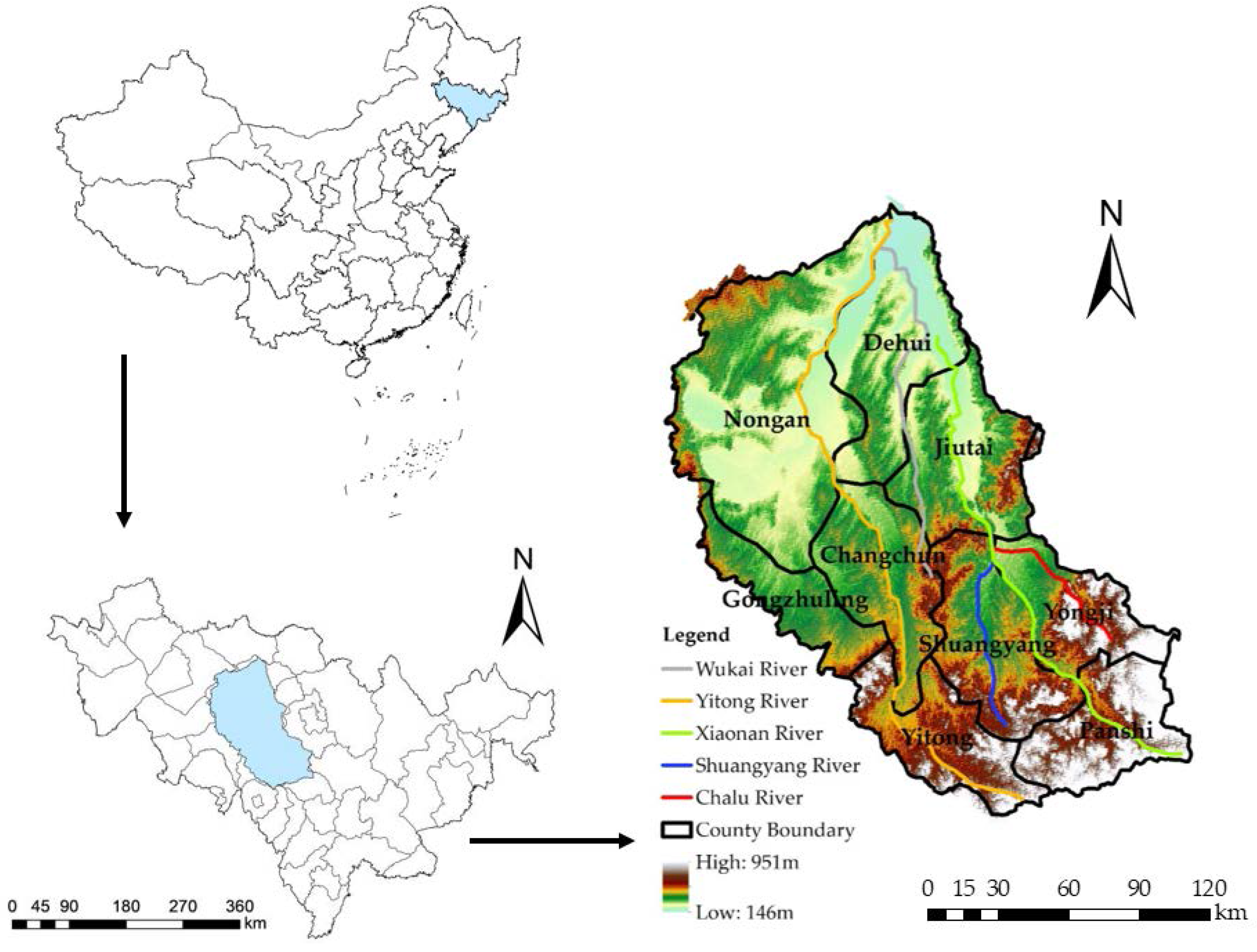


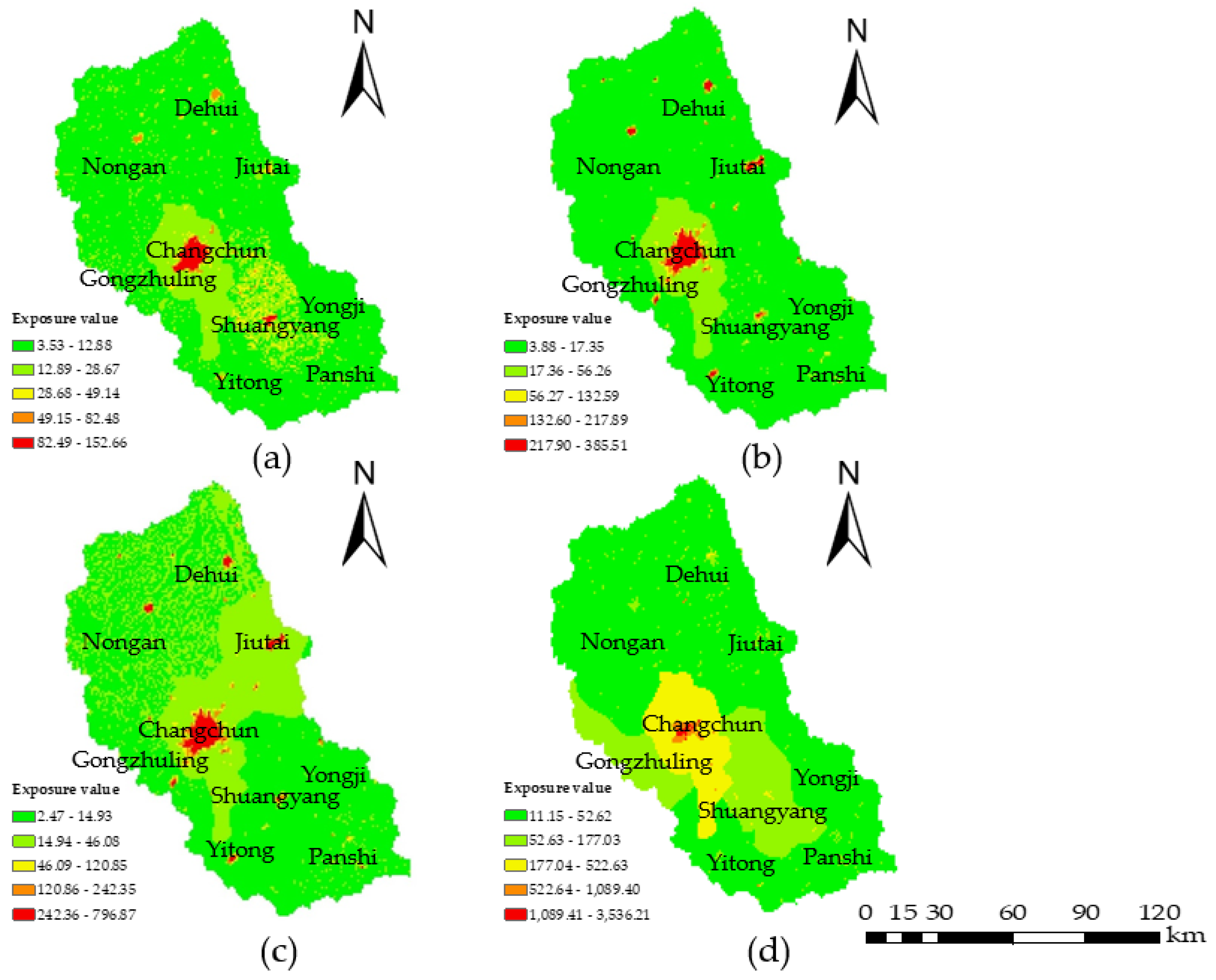
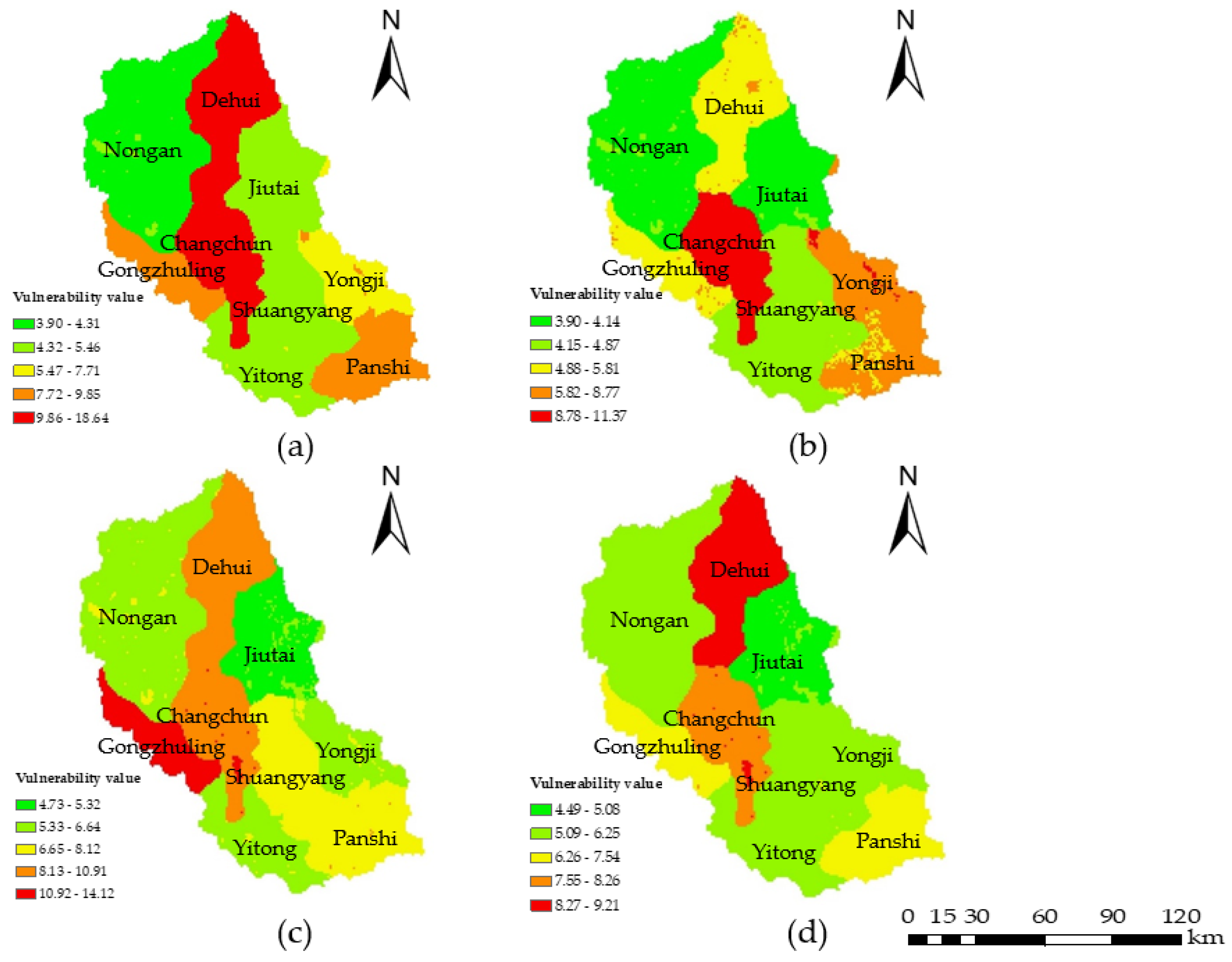
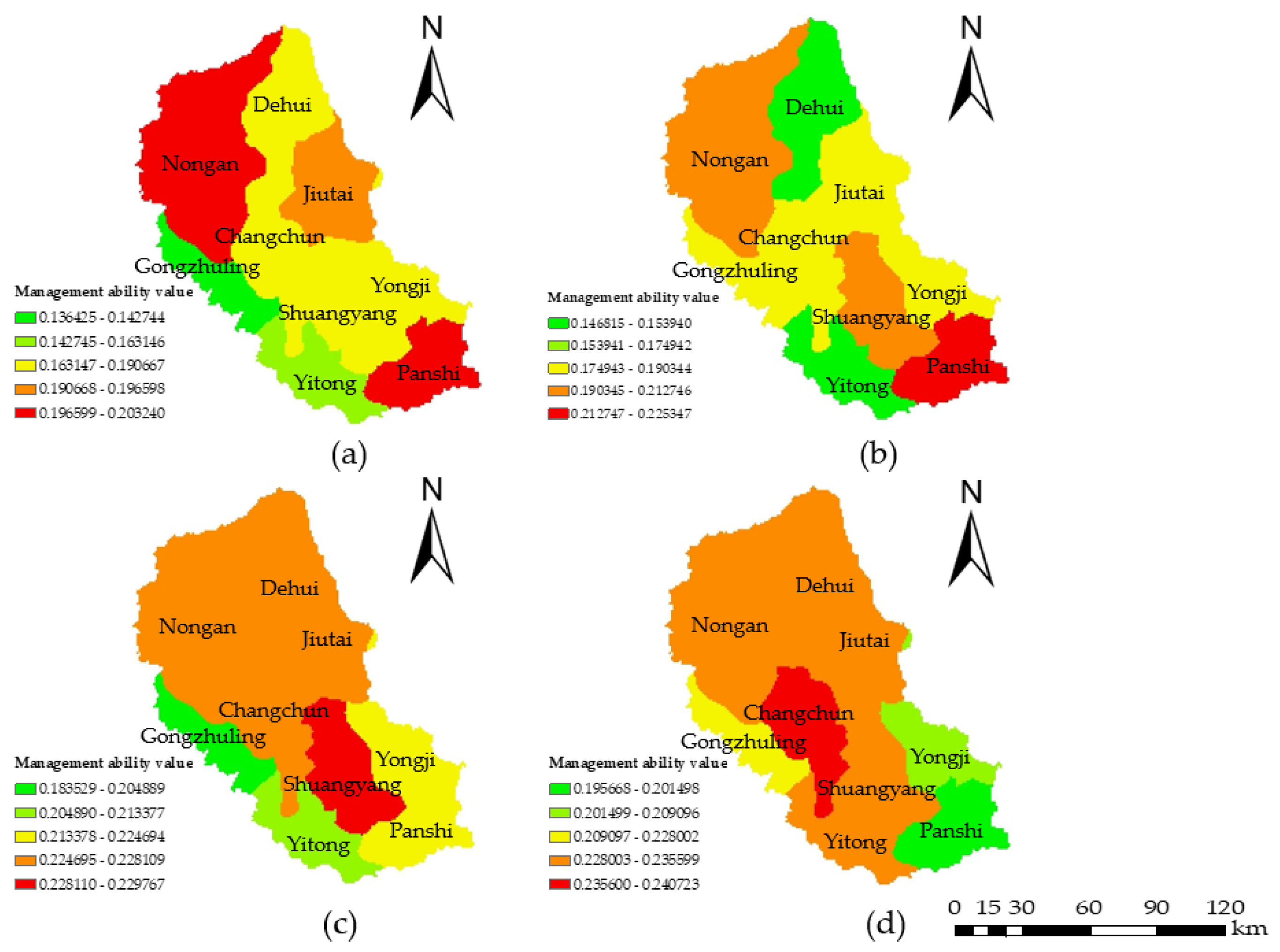
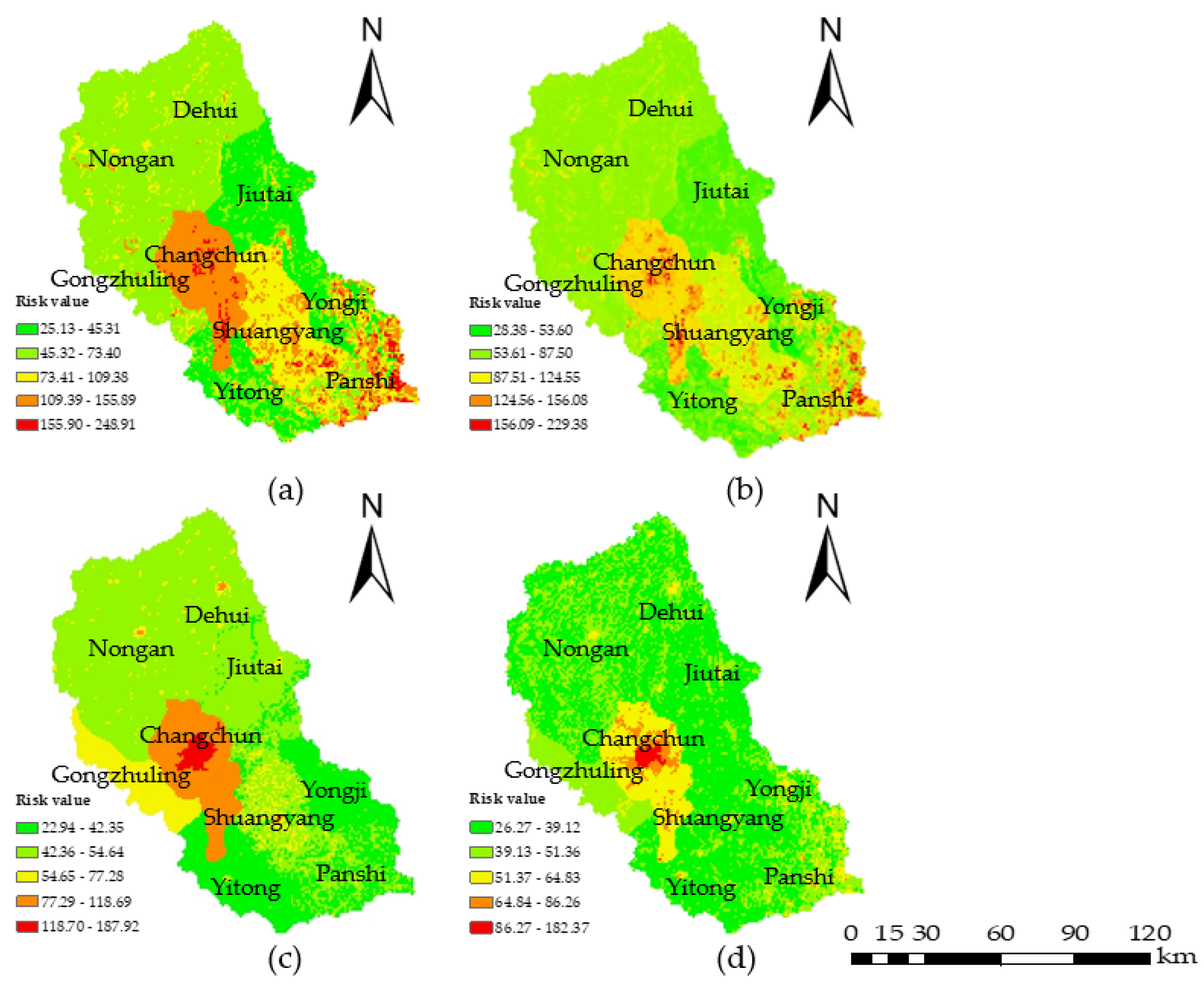
| Importance Intensity | Definition |
|---|---|
| 1 | Equal importance |
| 3 | Moderate importance of one over another |
| 5 | Strong importance of one over another |
| 7 | Very strong importance of one over another |
| 9 | Extreme importance of one over another |
| 2, 4, 6, 8 | Intermediate values |
| Reciprocals | Reciprocals for inverse comparison |
| Target Layer | Factor Layer | Indicator Layer |
|---|---|---|
| Hazard (B1) | Soil erosion emission (C1) Application amounts of chemical fertilizer and pesticide (C2) Industrial wastewater emission (C3) Domestic sewage emission (C4) Population density (C5) | |
| Exposure (B2) | ||
| Water environmental risk (A) | Farmland area (C6) | |
| Vulnerability (B3) | Number of factories (C7) | |
| Irrigation area (C8) | ||
| Regional management ability (B4) | Per-capita water consumption (C9) Per-10,000-yuan-GDP water consumption (C10) Standard-reaching rate of industrial wastewater (C11) | |
| Standard-reaching rate of domestic sewage (C12) | ||
| Rate of treated domestic garbage (C13) |
| Judgment Matrix | W1 | W2 | W3 | W4 | CIF |
|---|---|---|---|---|---|
| A | 0.378 | 0.253 | 0.172 | 0.197 | 0.00180 |
| B1 | 0.275 | 0.227 | 0.229 | 0.269 | 0.00178 |
| B2 | 0.091 | 0.515 | 0.394 | 0.01210 | |
| B3 | 0.342 | 0.365 | 0.293 | 0.00217 | |
| B4 | 0.361 | 0.329 | 0.310 | 0.00195 |
© 2018 by the authors. Licensee MDPI, Basel, Switzerland. This article is an open access article distributed under the terms and conditions of the Creative Commons Attribution (CC BY) license (http://creativecommons.org/licenses/by/4.0/).
Share and Cite
Di, H.; Liu, X.; Zhang, J.; Tong, Z.; Ji, M. The Spatial Distributions and Variations of Water Environmental Risk in Yinma River Basin, China. Int. J. Environ. Res. Public Health 2018, 15, 521. https://doi.org/10.3390/ijerph15030521
Di H, Liu X, Zhang J, Tong Z, Ji M. The Spatial Distributions and Variations of Water Environmental Risk in Yinma River Basin, China. International Journal of Environmental Research and Public Health. 2018; 15(3):521. https://doi.org/10.3390/ijerph15030521
Chicago/Turabian StyleDi, Hui, Xingpeng Liu, Jiquan Zhang, Zhijun Tong, and Meichen Ji. 2018. "The Spatial Distributions and Variations of Water Environmental Risk in Yinma River Basin, China" International Journal of Environmental Research and Public Health 15, no. 3: 521. https://doi.org/10.3390/ijerph15030521





